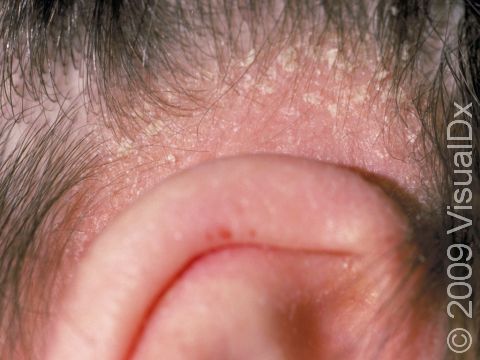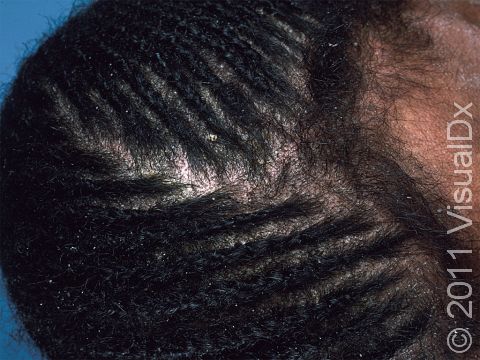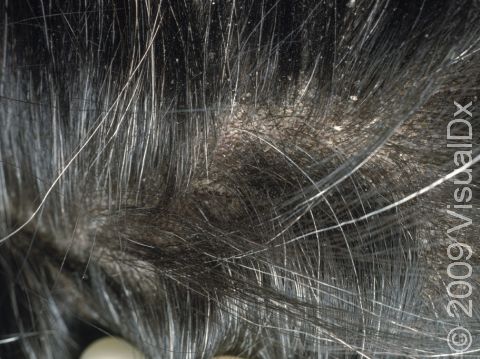Dandruff
Dandruff is the common name for seborrheic dermatitis of the scalp. Dandruff involves overproduction and flaking of skin cells, which can cause itchy skin on the scalp and sometimes behind the ears, on the face, and on the neck. Normal skin yeast called Pityrosporum ovale lives in oil-rich skin regions and plays a role in this disorder; the changes seen in the skin are due to the body’s inflammatory response to the yeast.
Dandruff seems to worsen with stress, dry weather, and infrequent shampooing. Although there is no cure for dandruff, control is usually possible with medicated shampoos and topical steroids (when inflammation is prominent).
Who's At Risk?
Dandruff occurs in 15%-20% of the population. Dandruff affects all races / ethnicities and may be a bit worse in men. It typically starts after puberty (although babies may have a variant called cradle cap). Dandruff usually peaks in severity around age 40 and then may improve. Severe dandruff can be seen in people with Parkinson disease, central nervous system problems, and HIV infection.
Signs & Symptoms
- The scalp is itchy and sheds white, oily skin flakes.
- One or more of the following areas has patches of scaly skin: the scalp, hairline, forehead, eyebrows, in between the eyebrows, and the area of the eyelid between the eye and the eyelashes (called the free lid margin).
- In lighter skin colors, affected areas may appear pink or red. In darker skin colors, the redness may be subtle; affected areas may appear purplish or darker brown, but the affected areas look lighter in color (hypopigmented).
Self-Care Guidelines
Most cases of dandruff are easy to control with nonprescription self-care treatments at home. These include:
- Frequent shampooing or a longer lather time with shampoo. If regular daily shampoo fails, consider an over-the-counter dandruff shampoo. There are several types on the market, and one may work better for one individual than another.
- Shampoos containing ketoconazole (Nizoral), selenium sulfide (Selsun Blue), 2% pyrithione zinc (Head & Shoulders), salicylic acid (Neutrogena T/Sal), or tar-based (Neutrogena T/Gel) compounds may be helpful. Consider occasionally rotating shampoos because how well a product works (its efficacy) can change with time.
- If the scalp is covered with widespread, dense scale, the scale may be removed by applying warm mineral oil or olive oil to the scalp and washing several hours later with a detergent, such as a dishwashing liquid or a tar-based shampoo.
- Some over-the-counter creams will help if the medicated shampoo is not working well enough. These can be added to the shampoo until there is improvement and then can be discontinued; these creams can be used again temporarily as needed and include:
- Creams that reduce the Pityrosporum yeast (clotrimazole [Lotrimin], miconazole [Monistat]).
- Hydrocortisone cream (eg, Cortaid), which may work well at first but may be less helpful if used for a long time.
- Managing eyelid inflammation (blepharitis) by gentle cleansing of the skin around the eyelashes with a cotton swab and baby shampoo (eg, Johnson’s Baby Shampoo).
Treatments
In the case of severe or stubborn dandruff, your medical professional may prescribe:
- Corticosteroid creams, lotions, or solutions.
- Sulfur or sulfacetamide products, such as a wash, cream, or lotion.
- Ketoconazole shampoo or cream.
- Tacrolimus (Protopic) ointment or pimecrolimus (Elidel) cream.
Visit Urgency
Seek medical care from a dermatologist or other medical professional if there is no response to self-care measures.
Trusted Links
References
Bolognia J, Schaffer JV, Cerroni L. Dermatology. 4th ed. Philadelphia, PA: Elsevier; 2018.
James WD, Elston D, Treat JR, Rosenbach MA. Andrew’s Diseases of the Skin. 13th ed. Philadelphia, PA: Elsevier; 2019.
Kang S, Amagai M, Bruckner AL, et al. Fitzpatrick’s Dermatology. 9th ed. New York, NY: McGraw-Hill Education; 2019.
Last modified on October 10th, 2023 at 9:19 am

Not sure what to look for?
Try our new Rash and Skin Condition Finder


